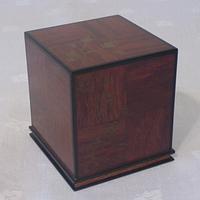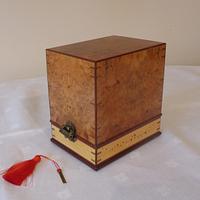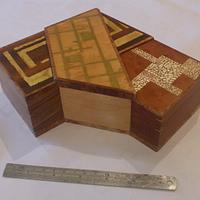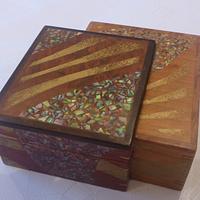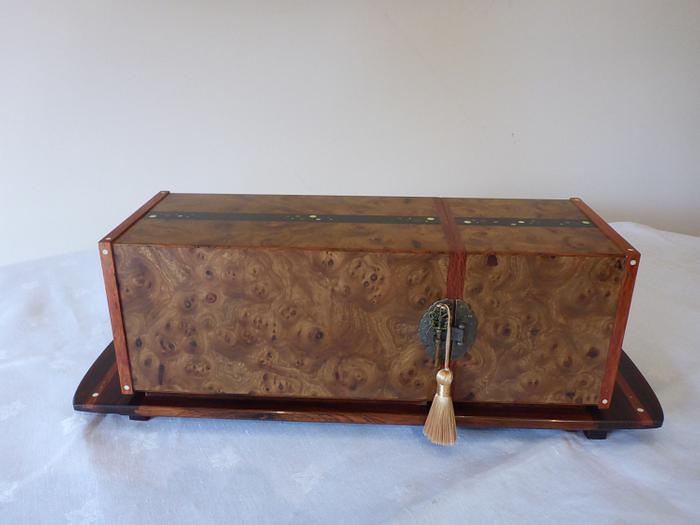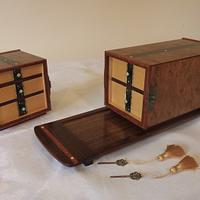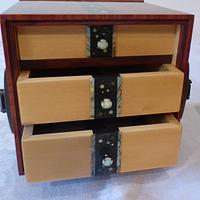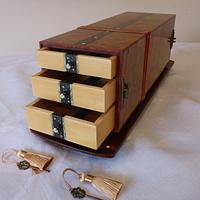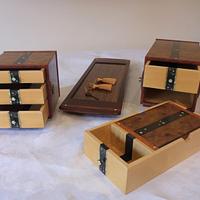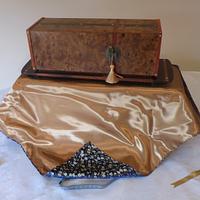Share your craft projects
Make new craft buddies
Ask craft questions
Blog your craft journey
Madburg
426 posts
and
20 followers
in about 3 years
in about 3 years
More from Madburg
Dottie Kogie
One of my first contemporary Japanese style boxes - Dotti Kogei.
This box, or is at a chest of drawers, was inspired by Japanese woodworker Suda Kenji. He has the status of a 'Living National Treasure' - Holder of an Important Intangible Cultural Property, Moku-kogei (Fine Woodwork). He is an exceptional 'Fine Woodworker' with his own gallery and studio in the small town of Ganura-cho, in the Gunma Prefecture of Japan. Check it out here. You will quickly see where I got my inspiration from…… I had the privilege of meeting Suda san when visiting his gallery and workshop in May 2019 - a truly memorable experience.
Suda-san describes his work as kogei - sort 'art crafts', though there is no real English translation. Kogei is a uniquely Japanese term that brings together a whole range of western concepts that embrace traditional woodwork, creativity, art, craft, and artistic expression. The word is used to categories items which though they have a function, are intrinsically 'beautiful things', which goes well beyond their utility value. You will see this in all Suda-sans boxes - traditional western style hinged lids are absent in his work, as are visible joints.
My Kogie box is presented in a typical Japanese Tsutsumi, gift wrapped fashion. It is offered in a paulownia (kiri) wooden outer storage box, called a Tomobako, or Kiribako when made from Kiri.
This box, or is at a chest of drawers, was inspired by Japanese woodworker Suda Kenji. He has the status of a 'Living National Treasure' - Holder of an Important Intangible Cultural Property, Moku-kogei (Fine Woodwork). He is an exceptional 'Fine Woodworker' with his own gallery and studio in the small town of Ganura-cho, in the Gunma Prefecture of Japan. Check it out here. You will quickly see where I got my inspiration from…… I had the privilege of meeting Suda san when visiting his gallery and workshop in May 2019 - a truly memorable experience.
Suda-san describes his work as kogei - sort 'art crafts', though there is no real English translation. Kogei is a uniquely Japanese term that brings together a whole range of western concepts that embrace traditional woodwork, creativity, art, craft, and artistic expression. The word is used to categories items which though they have a function, are intrinsically 'beautiful things', which goes well beyond their utility value. You will see this in all Suda-sans boxes - traditional western style hinged lids are absent in his work, as are visible joints.
My Kogie box is presented in a typical Japanese Tsutsumi, gift wrapped fashion. It is offered in a paulownia (kiri) wooden outer storage box, called a Tomobako, or Kiribako when made from Kiri.

The engraved wooden panel on the top, written in Japanese Kanji characters, has the title of the contents, my name, together with where and when it was made.
Dotti Kogei ドティ工芸
Kogei : 工芸
Box / Small chest of drawers : 箱/小引き出し
Made by : 製作者
Martin Burgoyne : マーティン・ブゴイン
Jarrahdale WA : ジャラデール 市 西オーストラリア州
September 2018 to March 2019 : 自2018年9月 至 2019年3 月
As well as its outer Kiribako, my kogei box is also gift wrapped to add more 'suspense' and mystery to what lies inside. A traditional Furoshiki fabric square, sewn by my wife, is used for the 'gift' wrapping.

The Kiribako and Furoshiki cover are both tied with traditional Japanese Sanada Himo cotton tapes.



So, to the actual 'box'. It sits on a decorative tray made from Rosewood and Walnut, with inlays of lace wood, together with shell and opal dots. The dots are a theme that goes across all elements of the box. The 'box' is in fact two small chests of drawers that can be locked together by traditional Japanese spring locks. Once unlocked the two chests of drawers can be separated, turned around and placed back on the tray so that the drawers are accessible.


They can also be taken off the tray so that it can be used separately, or as a place for the contents of drawers.
The two chests of drawers have book matched burr elm veneers with highlights of rosewood and lace wood. A black banding sprinkled with gold dust, and with inlays of shell and opal dots surrounds the two chests of drawers. The inside is veneered with maple.

The five internal drawers are made of lime and have gold dust sprinkled interiors - a change from my usual goat suede. They continue the black banding theme of the outside of the chests, with shell, opal and gold dust inlays on their fronts.

The drawer knobs are made of Opal cabochons mounted in silver claw settings - they are actually stud earrings! The drawers are jointed using tiny biscuits, unlike Suda-sans secret mitred dovetails!!
I included a separate 'hidden' box inside. This small box, 'hidden' at the back of the largest drawer, matches the main chests, with similar book matched burr elm veneers, lace wood bandings and a black banding with gold dust highlights and shell and opal dots. It is lined with blue goat skin suede, to match the outer Furoshiki fabric.


In typical Japanese woodworking fashion, there are no visible joints. A feature we use in western woodwork, often to demonstrate our prowess as craftsmen, but a practice frowned upon in Japanese fine woodwork!!
In my Japanese period I have moved away from the marquetry that I had so enjoyed doing in past years. A comment in Suda-sans book about using the natural beauty of the wood, rather than too much vulgar decoration made me re-think ….....
Why Dotti Kogei? Its name is derived from the shell and opal 'dots' which bring the different elements of this kogei box together, and of course my wife's first name is Dorothy!
This box led to a commission for another similar box Starry, Starry Night that you can see here
I hope you enjoyed looking at it, as much as I enjoyed making it.
2 Comments
Another beautiful creation, wonderfully presented.
Ryan/// ~sigh~ I blew up another bowl. Moke told me "I made the inside bigger than the outside".
What I like about these designs is there are so many layers of discovery. Just when you think you've found them all, there is one more!









